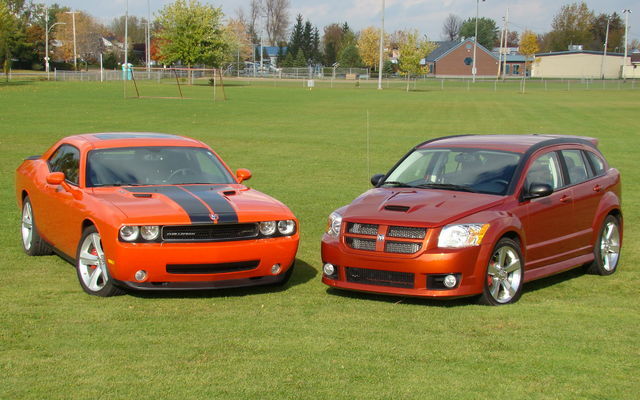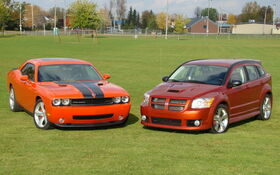SRT4 vs. SRT8: One for the father, the other for the son!
It was completely by chance that we came to do a head to head comparison between these two cars. My colleague Sylvain Raymond was putting the Caliber SRT4 through its paces at the same time as I was turning heads behind the wheel of the new Challenger SRT8. Moreover, we seemed to keep running into each other over and over again, so we decided to meet on a country road, each in the saddle of his respective steed.
One nice afternoon and a little time was all we needed to put these cars through a series of tests, over the course of which we learned that even though the Challenger costs twice as much, is twice as fuel-thirsty and has twice as many cylinders as the Caliber, its performances are not twice as good. Before jumping right into the numbers, we should clarify that the tests were done with a 2009 Challenger SRT8 with a standard transmission, but it is a 2008 SRT8 500 with an automatic transmission in the pictures. Obviously, the numbers from this version may not have been the same. Nevertheless, the Caliber really has the means to surprise. Its weight surely plays a key role in the performance results despite its unfavourable weight/power ratio.
- Also: 2009 Dodge Challenger SRT8 : A real throwback!
- Also: 2009 Dodge Challenger SRT8: Six Speeds Makes it Sexy
In the straightaway…
Naturally, you get a very different feeling from a V8 than you do from a turbocharged engine. 425 horses strong, the Challenger’s 6.1-litre V8 HEMI powers you along, all the while serenading you with a magnificent eight-cylinder symphony. The Caliber, on the other hand, has a four-cylinder 2.4-litre that whistles in your ear while you grip the steering wheel tightly with both hands just to keep it on the right path. As the numbers below demonstrate, both cars offer potent accelerations. Daddy, with his Challenger, could make the son eat his dust, but only by a few tenths of a second. And sonny boy could make up the time by continuing on his way while Pops stops to fill up.
Both the SRT4 and the SRT8 come equipped with a computer capable of transmitting a ton of performance information such as the times for the quarter mile and 0-100km/h, or even the G-force in turns. However, the results shown in the quarter mile tests turn out to be different from those that we obtained with the help of our measurement tool, the V-box. Our colleague Marc Lachapelle, a master in the art of performance and the person that oversaw the testing for us, looked at the question and concluded that the tool used by Chrysler performed the calculations using the one foot roll out rule. As in the data recorded on drag strips, the calculations do not include the first foot of the distance travelled, and although it seems incredible, this difference can create discrepancies of several tenths of a second in the results. Basically, before consulting the numbers, find out how they are calculated.
On the track
This is where the two cars behave completely differently from one another. Beginning with the Challenger, in order to propel 425 horses and such a heavy load on a circuit, a very good structural base is needed. The Challenger has no problem in this regard. The chassis is rigid and the suspension components of this SRT8 are marvellously calibrated to deal with the pavement and the weight transfers. However, it still has to contend with a roll, but the performance tires mounted on 20-inch rims help diminish the effect. But the Challenger is not an agile car like a BMW M3. You have to struggle more to hold its line and you have to tame its imprecise steering. Obviously, like in the good old days, you have the possibility and the pleasure of setting the SRT8’s tail end free. But above all, the greatest joy that one gets from it is handling the stick shift with all of the strength it requires, while making the V8 sing the most intoxicating range of notes.
The Caliber is another story. Here, the 285 horses are in control and the rest have no choice but to follow. The biggest problem with this car is obviously that all of its power comes from the front wheels, thereby creating a strong torque effect for which you will have to compensate by by wrestling with steering wheel just to keep on the same trajectory – especially on the track. Naturally, the smaller Caliber is an easier machine to handle than the Challenger. Its steering is excellent and the struts help the car withstand impacts that a regular Caliber would not be able to take. Fitted with 19-inch Eagle F1 tires, the car also bites into turns with confidence despite a tendency toward an oversteer. Only the suspension is a little disappointing, as it is both dry hard and a little too flexible for the vehicle’s needs.
Dodge SRT4 Challenger SRT8
Engine V4, 2.4 litres turbo V8, 6.1 litres
Transmission Six-speed standard Six-speed standard
Power 285 hp at 6,400 rpm 425 hp at 6,200 rpm
Torque 265 lb.-ft. at 5,600 rpm 420 lb.-ft. at 4,800 rpm
Weight 1,447 kilos 1,891 kilos
Weight/power 5.1 kilos per horsepower 4.45 kilos per horsepower
0-100 km/h 6.3 seconds 5.6 seconds
80-120 km/h 4.0 seconds 5.63 seconds
1/4 mile 14.87 sec. at 163.5 km/h 13.85 sec. at 170.1 km/h
As for the brakes, the engineers from Street and Racing Technology (SRT) really went all out. Both cars brake brilliantly and demonstrate uncommon endurance comparable to the world’s most talented sports cars.
On the road
A recent round trip between Montréal and Québec showed me that the Challenger is a car that does not only excel on the track. In fact, despite the SRT8’s firm suspension, it is reasonably comfortable, mainly because of its superb bucket seats. The car is stable, well grounded to the pavement and very well sound proofed. Obviously, the visibility is not perfect, but that is price to pay to benefit from lines as macho as these.
With the Caliber, comfort is rather limited and soundproofing is nearly non-existent. The muffler is not silent at all and wind noise comes from every which way. Frankly, it is very poor in this regard. However, despite a rather hard suspension, the Caliber SRT4 is much better suited to daily use that was its predecessor, based on the Neon. The conveniences are more numerous, the driving position is pleasant and its practicality stands out. Nonetheless, it is clear that the buyer in search of performance will have to compromise on comfort with the Caliber.
Are they fuel efficient?
Gasoline consumption for each of these cars is in proportion to the size and engine power. Under normal circumstances, the Caliber SRT4 consumes a little less than 11 litres per 100 kilometres, while the Challenger uses around 16 litres of fuel per 100km. Of course, you will not have numbers that good if you want to have fun by playing near the red zone, and even less so on a track. Yet again, that is the price of performance…
And the price?
If dear old Dad is going to shell out for both of these rockets, he is going to need $75,000 give or take. About $50,000 for the Challenger SRT8 with a standard transmission, and half of that for a Caliber SRT4 on special right now. In both cases, the price is rather tempting. And if the first is already a classic that will hardly depreciate at all, the other will certainly, thanks to its performances, leave many Honda enthusiasts flabbergasted.
It sure is nice to see that in these rational times where money the almighty dollar has the final say, these manufacturers (even though they are in financial difficulty) continue to let loose by offering us such appealing cars. In closing, remember that Chrysler’s SRT line also includes the 300 and Charger sedans, as well as the Grand Cherokee sport utility vehicle.












